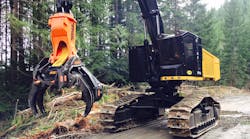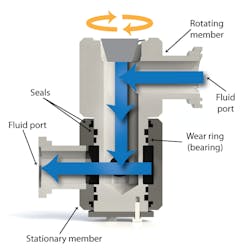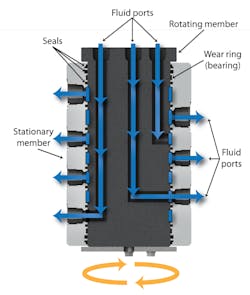*Editor's Note: This article was originally published in December 2019 and updated in October 2022.
A rotary union is the fitting used to transfer the pressurized fluid from a fixed inlet to rotating outlet, without obstructing the flow of the fluid or air. This fitting is sometimes referred to as a swivel joint, rotating manifold, or rotary union.
Below, Figure 1 shows a swivel fitting containing a single circuit to transmit fluid. These fittings pay for themselves many times over by reducing stress on a hose, thereby extending its life. This describes one end of the swivel spectrum.
At the other end are rotary unions that transmit fluid for multiple circuit lines through a single manifold that rotates continuously. In general, fluid enters one or more ports in the stationary portion of the manifold and exits through one or more ports on the other portion, which rotates with the machine. A rotary seal between the two halves contains the pressurized fluid, yet allows relative rotation between the halves. For simplicity of discussion, the term rotary union will be used here as an all-inclusive term to describe swivel fittings and rotating manifolds.
The rotary seal is probably the most critical part of the device, whether a swivel fitting or rotary manifold. This is because the seal between the rotating and stationary halves must be tight enough to prevent leakage of pressurized fluid, while introducing as little torque drag as possible. Torque drag is a measure of the swivel joint’s resistance to rotation.
These seals vary in complexity depending on the application. For simple swivel fittings undergoing less than 360 degrees of rotation, the seal may be little more than two machined surfaces loaded against each other. Rotating manifolds, however, may require ball bearings and spring-loaded seals with auxiliary loading by fluid pressure. If the seal is not pressure balanced (fluid pressure acting on opposite sides of the seal), torque drag may increase with fluid pressure.
As with any custom-engineered product, manufacturers can supply a swivel joint to meet virtually any specification. However, a variety of standard swivels is available to keep costs reasonable.
READ MORE: Combining Functions Saves Time, Cuts Cost, Improves Quality
Configurations
Most swivel fittings are standard catalog items considered specialty fittings. However, depending on their complexity and manufacturer, rotating manifolds often are engineered items that must be special-ordered, especially if more than four independent flow paths are required. Standard configurations of swivel joints include straight through (where flow paths are coaxial) and right-angle (where outlet ports are perpendicular to inlet ports). A less common design is the offset configuration, which is essentially a straight-through design with a 90-degree elbow at each end.
Available space and fluid line routing generally determine which configuration should be used. Keep in mind that axial length and the overall diameter of a rotating manifold increases with the number of independent flow paths. In some applications, directional control valves can be mounted on the rotating end of the machine to allow routing only two common flow paths (pressure and return) through the rotating manifold. In this case, all valves connect to the common flow paths through a conventional manifold or line fittings.
In some instances, a valve is built into the rotating manifold to allow or block fluid flow as the rotating member advances through a revolution. Internal passageways open and close as the manifold turns, allowing fluid to flow only when the rotating member is in certain positions — a setup that operates much like a camshaft and cam follower. As with a cam, this arrangement is not as easy to reconfigure as using electrically actuated valves. However, it can be very practical for applications that have a repetitive, fixed operation — such as an indexing table.
Other considerations include through holes and integral valves. A hole through the center of the rotating manifold may be necessary to provide access for electrical lines, a shaft, or other machine elements that must be routed from the stationary member to the rotating one.
Mounting the rotary union in improper ways can cause vibration. The way a rotary union is secured to the equipment also plays an important role. Proper support for the rotary union based on its weight and center of gravity must be considered. The inappropriate location of a torque arm with respect to the mounting can transmit side load, which can increase the torque drag or damage or reduce the seal's life. The mounting flange and the torque arm can be welded or bolted to the rotary union depending upon the application. The rotary union can also be painted or provide some other means to prevent metal corrosion.
Type of Motion
Just as swivel joints and rotating manifolds should exhibit minimal friction to allow free rotation, hoses and piping should transmit as little external load as possible to the swivel joint, unless the swivel joint is designed with adequate bearings to support external loads. Otherwise, seals can wear prematurely and leak. In extreme cases, the rotating joint itself may fracture.
Just the weight of components — hoses, tube assemblies, and fittings — may be substantial enough to transmit an external load to the swivel. For instance, the weight of a 10-ft. section of spiral-wound hose and the load exerted by the fluid under pressure can easily be underestimated or overlooked. However, it can transmit a substantial side load or bending moment on a swivel joint.
Size and Mounting
The swivel joint must have ports of the correct size and geometry to accommodate hose or tubing assemblies mating to it. Ensure that enough room is available on the equipment structure to accommodate the swivel joint. For swivel fittings, as with any fitting, the higher the flow rating, the larger the ID and external envelope of the fitting. For rotating unions, enough clearance must be provided between ports to allow threading and unthreading hose- and tube-end fittings to the manifold. Also keep in mind the physical size of the rotating union. The more fluid lines which are routed through the manifold, the larger will be its overall size.
A means must exist to either mount the swivel to the structure or to mount the connecting hose and/or tubing to the structure adjacent to the swivel joint. This practice helps prevent misalignment from long runs of unsupported hose or tubing. Misalignment can transmit side loads to the swivel, causing the detrimental effects outlined above. Side loading can also be introduced by forcing misaligned rigid tubing into position for mounting. The assembly may fit together, but life and performance of the swivel joint may suffer.
Selection Considerations
When selecting swivel joints, not adhering to manufacturers' specifications can result in leakage, premature failure of the joint, premature failure of the hose, or all of these conditions. Exceeding manufacturers' published pressure ratings can cause fluid leakage by pushing fluid past the joint's rotary seals.
Excessive pressure can also increase friction, leading to premature wear and higher torque drag. The seal material also plays an important role in controlling friction, as harder material can increase the friction but is more stable at higher pressures and temperatures. However, seals made from a softer material may reduce friction, but they are not stable at high pressures.
Also ensure that the swivel joint is compatible with the application environment — the chemical composition of the fluid being used, operating temperature, and the external environment. Swivel joints are readily available in ductile iron, steel, aluminum, brass, and other materials to match the chemistry and temperature of the fluid with that of the seals and surroundings. Perhaps more importantly, a variety of seal materials are available to accommodate any hydraulic fluid along with a wide range of temperatures.
READ MORE: How to Protect Hydraulic Swivels from Hostile Environments
If possible, mount the swivel joint where it will have minimal exposure to abrasive or corrosive particles. In some applications, an elastomeric boot, bellows, or cover may be necessary to help isolate the seal area of the swivel joint from an extremely dirty environment.
This article was written and contributed by Vinay Patil, a mechanical design engineer at United Equipment Accessories.
This article is part of Power & Motion's Fundamentals of Fluid Power: Hydraulics ebook; download the full guide to learn about the latest technologies and design methods for developing modern hydraulic systems.




